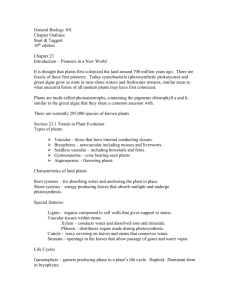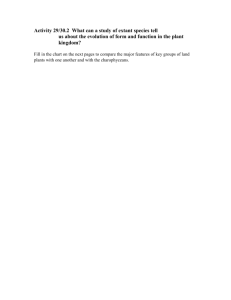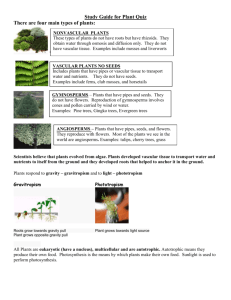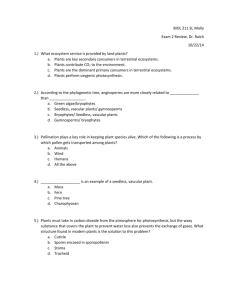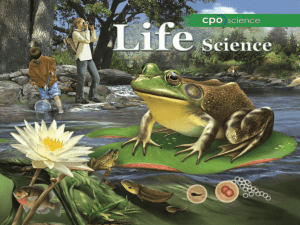Answers to Mastering Concepts Questions
advertisement
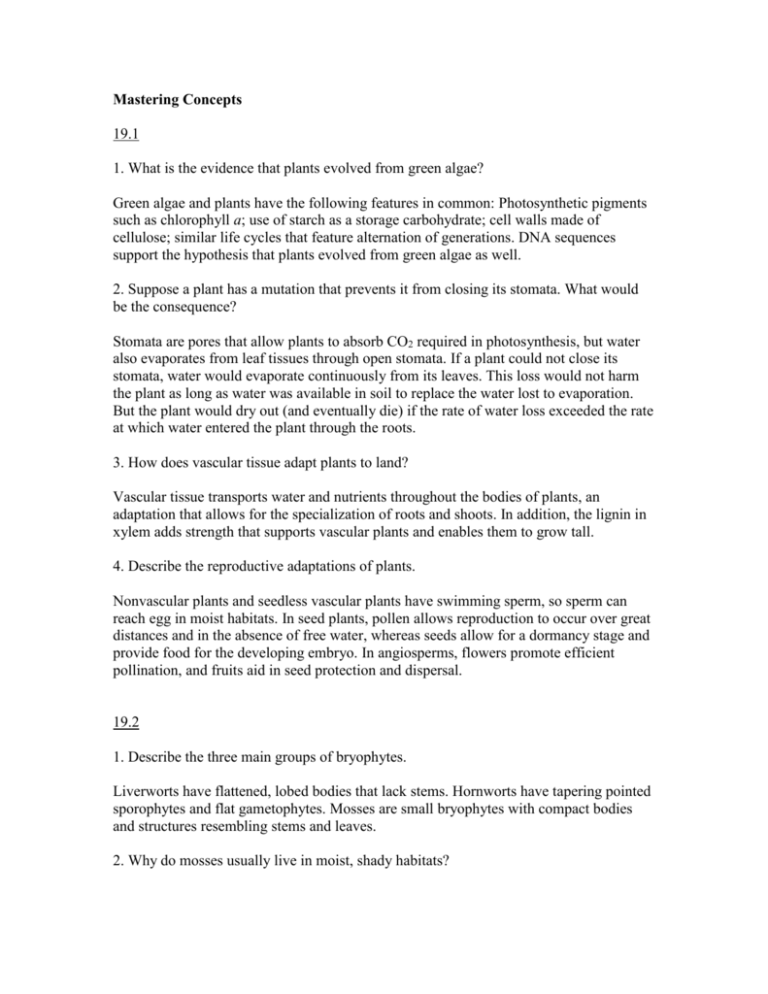
Mastering Concepts 19.1 1. What is the evidence that plants evolved from green algae? Green algae and plants have the following features in common: Photosynthetic pigments such as chlorophyll a; use of starch as a storage carbohydrate; cell walls made of cellulose; similar life cycles that feature alternation of generations. DNA sequences support the hypothesis that plants evolved from green algae as well. 2. Suppose a plant has a mutation that prevents it from closing its stomata. What would be the consequence? Stomata are pores that allow plants to absorb CO2 required in photosynthesis, but water also evaporates from leaf tissues through open stomata. If a plant could not close its stomata, water would evaporate continuously from its leaves. This loss would not harm the plant as long as water was available in soil to replace the water lost to evaporation. But the plant would dry out (and eventually die) if the rate of water loss exceeded the rate at which water entered the plant through the roots. 3. How does vascular tissue adapt plants to land? Vascular tissue transports water and nutrients throughout the bodies of plants, an adaptation that allows for the specialization of roots and shoots. In addition, the lignin in xylem adds strength that supports vascular plants and enables them to grow tall. 4. Describe the reproductive adaptations of plants. Nonvascular plants and seedless vascular plants have swimming sperm, so sperm can reach egg in moist habitats. In seed plants, pollen allows reproduction to occur over great distances and in the absence of free water, whereas seeds allow for a dormancy stage and provide food for the developing embryo. In angiosperms, flowers promote efficient pollination, and fruits aid in seed protection and dispersal. 19.2 1. Describe the three main groups of bryophytes. Liverworts have flattened, lobed bodies that lack stems. Hornworts have tapering pointed sporophytes and flat gametophytes. Mosses are small bryophytes with compact bodies and structures resembling stems and leaves. 2. Why do mosses usually live in moist, shady habitats? Mosses occur in moist, shady habitats in part because they lack vascular tissue. Without vascular tissues for support, their bodies remain small; and without an internal system to transport water within the moss, each cell must acquire water on its own. A second reason mosses are restricted to moist habitats is that they must be covered by a film of water for sexual reproduction to occur. 19.3 1. Describe the four groups of seedless vascular plants. Club and spike mosses have simple leaves and reproductive structures that look like clubs or spikes. Whisk ferns have rhizomes but lack roots and leaves. Horsetails have branched rhizomes and stems that bear spores at their tips. True ferns have fronds that grow from rhizomes and spores on the undersides of the fronds. 2. How do seedless vascular plants reproduce? Cells in a diploid sporophyte such as a fern frond undergo meiosis, releasing haploid spores that germinate and develop into gametophytes. The gametophyte produce eggs and sperm cells by mitosis. Sperm swim to an egg, and fertilization takes place. The fertilized egg develops into a diploid sporophyte. 3. How are seedless vascular plants similar to and different from bryophytes? Both are tied to water by swimming sperm that require water to reach eggs. Neither group has pollen, seeds, flowers, or fruits. Seedless vascular plants, however, have xylem and phloem, which bryophytes lack. 19.4 1. What are the characteristics of gymnosperms? Gymnosperms have vascular tissue, pollen, and naked seeds that are not enclosed in fruits. 2. What are the four groups of gymnosperms? The four groups of gymnosperms are cycads, ginkgos, conifers, and gnetophytes. 3. What is the role of cones in conifer reproduction? Meiosis, pollination, and fertilization occur inside the cone. The gametophyte generation is also produced within cones. 4. What happens during and after pollination? During pollination, a pollen grain is delivered to a female gametophyte. The pollen grain germinates, forming a pollen tube that grows into the ovule, toward the egg cell. During fertilization, a haploid sperm nucleus unites with the haploid egg cell, producing a diploid zygote (the first cell of the sporophyte generation). The zygote will grow into an embryo, which is packaged inside a seed. 19.5 1. What are the two largest clades of angiosperms? The eudicots and monocots are the two largest clades of angiosperms. 2. In what ways are the life cycles of angiosperms similar to and different from those of conifers? Similarities include the conspicuous sporophyte stage and the presence of pollen. However, unlike conifers, the angiosperms produce flowers and fruits. The other major difference is the production of the endosperm, which provides nutrients for the developing angiosperm embryo. 3. What is the relationship between flowers and fruits? The flowers are the structures that produce pollen and egg cells. After fertilization occurs in the ovary, parts of the flower develop into the fruit, which encloses the seeds. 4. How do animals participate in angiosperm reproduction? When searching for food, animals pick up pollen from one plant and transfer it to the next plant they feed on. In this way they pollinate the plants. Animals also disperse fruits and seeds to new habitats. 19.6 1. Why do researchers collect DNA from permafrost? The permafrost can contain preserved DNA from ancient plants and animals, allowing researchers to reconstruct the ancient ecosystem. 2. What are some alternative hypotheses for why the researchers failed to recover any DNA from sediments that were more than 300,000 to 400,000 years old? How would you test your hypotheses? One example of a hypothesis would be that DNA disintegrates after 300,000 to 400,000 years, even frozen in the permafrost. One way to test this would be to go to other areas known to have life 300,000 to 400,000 years ago, take core samples, and see if DNA appears in any of the samples. Write It Out 1. What characteristics do all land plants have in common? All land plants are photosynthetic multicellular organisms with eukaryotic cells, cellulose cell walls, starch as a carbohydrate storage material, and a life cycle that features an alternation of generations. The aboveground surface of the plant also typically has a cuticle and stomata. 2. Analyze the alternation of generations common to all plants. If you isolated all of the gametes that one gametophyte produced and analyzed the DNA, would you see variation among the gametes? The haploid gametes are the product of mitosis in the haploid gametophyte. Other than random mutations, you should therefore not see variation among the gametes. 3. How are terrestrial habitats different from aquatic habitats? List the adaptations that enable plants to obtain resources, transport materials, and reproduce; explain how each adaptation contributes to reproductive success on land. In terrestrial environments the nutrients are either in the ground (requiring a root system) or in the atmosphere (requiring stomata). Also, land plants are in danger of losing water to their environment; terrestrial habitats therefore have selected for a cuticle. Many plants contain a vascular system that transports nutrients, water, and sugars between roots and stems, allowing for large plant size. Pollen allows fertilization to take place without the aid of water. Seeds and fruits improve reproductive success by protecting the offspring and providing for their dispersal. 4. List the characteristics that distinguish the four major groups of plants, then provide an example of a plant within each group. Bryophytes such as mosses lack vascular tissue and produce swimming sperm. Seedless vascular plants such as ferns have vascular tissue and produce swimming sperm. Gymnosperms have vascular tissue, pollen grains, and seeds but do not produce flowers or fruits. Angiosperms have vascular tissue, pollen grains, flowers, fruits, and seeds. 5. Give at least two explanations for the observation that bryophytes are much smaller than most vascular plants. How can increased height be adaptive? In what circumstances is small size adaptive? One explanation is that bryophytes lack vascular tissue, so they lack the support necessary for large size. Another is that the sperm must swim from one individual to the next, selecting for small plants that grow close together. Increased height can be adaptive in the competition for light. Small size can be adaptive if it allows for rapid development to reproductive maturity. 6. A fern plant can produce as many as 50 million spores a year. How are these spores similar to and different from seeds? In a fern population that is neither shrinking nor growing, approximately what proportion of these spores is likely to survive long enough to reproduce? What factors might determine whether an individual spore successfully produces a new fern plant? (a) A fern’s spores are similar to seeds in that both participate in reproduction and dispersal. However, a spore is a haploid structure produced by meiosis; a seed contains a diploid embryo and its food supply packaged inside a tough outer coating. Unlike spores, seeds may stay dormant for years until conditions are right for germination. (b) In the stable fern population, only a tiny fraction of the spores survives – just enough to replace the parents. (c) Factors that influence whether a spore produces a new fern plant include the substrate where the spore lands, herbivores, sunlight, nutrients, and moisture. 7. How do the adaptations of gymnosperms and angiosperms enable them to live in drier habitats than bryophytes and seedless vascular plants? Pollen carried by wind or animals enables plants to reproduce in the absence of free water; seeds protect the embryo (young sporophyte) until conditions are optimal for germination and growth. 8. Describe how the petals, ovary, and ovule of flowers participate in reproduction. What happens to each part after fertilization? Brightly colored petals attract pollinators; after fertilization, the petals typically wither and drop off. The ovary contains one or more ovules; after fertilization, the ovary develops into the fruit. Each ovule contains a female gametophyte; after fertilization, an ovule develops into a seed. 9. Draw a bar graph showing the number of species in each group of plants. Is there a correlation between the age of the plant group and the group’s diversity? Graphs should be based on the data in table 19.1. The angiosperms, which evolved last, are by far the most diverse plants. The second most diverse group, the nonvascular plants, evolved first. There is no correlation between the age of the group and its diversity. 10. The immature fruit of the opium poppy produces many chemicals that affect animal nervous systems. In what way might these chemicals benefit the plant? If chemicals in the immature fruit produce a negative effect on the animal nervous system, then animals would avoid the fruit, giving the seeds time to mature. If chemicals remaining in the mature fruit produce a pleasant effect on the animal nervous system, then animals would ingest more of the fruit, spreading the seeds over a greater range. 11. Scientists have studied plant populations that have colonized areas with low rates of herbivory compared to the plant’s previous habitat. After many generations in the new habitat, the plants produce fewer defense chemicals and grow larger than plants in the ancestral population. How does natural selection explain these observations? (Hint: producing defense chemicals uses energy.) Any plant should invest its resources in ways that promote its reproductive success. Since producing defense chemicals uses energy, and herbivores pose a minimal threat in the new habitat, a plant should invest less in defense chemicals and more in additional leaf area and stem height, allowing the plant to grow taller. 12. In a sentence or two, either support or refute the following statement: The pollen grains of angiosperms are homologous to the spores of bryophytes. The statement is incorrect. Pollen grains are male gametophytes; they produce sperm nuclei by mitosis. The spores of bryophytes are the products of meiosis in the sporophyte. They give rise to the gametophytes. 13. Some angiosperm species have exclusive relationships with just one species of pollinator. How would this relationship benefit the plant? What are the risks to the plant? The relationship is efficient for the plant because it means that many pollen grains will reach another plant of the same species. The risk is that if the pollinator becomes extinct, the plant may no longer be able to reproduce. 14. Compare and contrast the life cycles of the four groups of plants. How does each group represent a variation on the common theme of alternation of generations? All four groups of plants produce haploid gametophytes and diploid sporophytes, but the relative sizes of these structures can vary. In bryophytes, the gametophyte is relatively large and carries out photosynthesis; the sporophyte can be small and depends on the gametophyte for nutrition. In seedless vascular plants, the gametophyte carries out photosynthesis, but it is very small and is quickly dwarfed by the growing sporophyte. In gymnosperms and angiosperms, the gametophytes are extremely small and depend on the much larger sporophyte for nutrition. In addition, the gametophytes produce gametes in all groups of plants. In bryophytes and seedless vascular plants, the sperm cells require water to swim to the egg. In gymnosperms and angiosperms, the sperm nuclei are packaged into pollen, which is typically carried to the plant by wind or animals and therefore does not require free water. 15. A slight change in a plant species’ flower structure might favor a different pollinator. How might such a change in flower structure lead to a new plant species? How does coevolution between flowering plants and animal pollinators help explain the huge diversity of angiosperms? If a change in flower structure attracts a different pollinator to the plant, then the new plant variety may no longer exchange gametes with the “parent” type. This reproductive barrier would represent the development of a new species. In this way, over millions of years, mutations in flowering plants may have selected for new types of pollinators. Similarly, a mutation in the pollinator might simultaneously select for new flower structures. Since pollinators and flowers are tied together evolutionarily, mutations in one affect the other, so evolution occurs quickly. 16. Suppose you and a friend are hiking and you see an unfamiliar plant. What observations would you make in trying to determine which type of plant it is? The size of the plant and the presence of true roots and leaves would be two possible clues. Another strategy would be to look at the reproductive structures, if present. For example, the presence of flowers or fruits indicates an angiosperm; cones indicate a gymnosperm; spores produced in capsules or on leaves could indicate a bryophyte or a seedless vascular plant. 17. People often move plants from one part of the world to another. Sometimes, an introduced plant species can become invasive, taking over native plant populations. The U.S. Department of Agriculture manages the National Invasive Species Information Center, whose website maintains a list of invasive plants. Which plant species are considered invasive in your home state? Why are those species harmful? Should invasive plants be eradicated? How? First part of answer will vary. Invasive plant species are harmful because they compete for water and soil nutrients, shade out native plants, displace native vegetation, and girdle or choke out other plants. Answers about eradication will vary. 18. Human activities and natural phenomena can drive plant species to extinction. The U.S. Department of Agriculture Natural Resources Conservation Service maintains lists of threatened and endangered plant species. What are some examples of threatened or endangered species in your area? What are the most important threats to those species? What are the potential consequences of a plant species’ extinction? What steps should we take to save threatened and endangered plants? First part of question may vary. Important threats to endangered species could include disease, grazing, climate change, wildfires, human activity, invasive species, or agriculture. Potential consequences of extinction could include loss of genetic diversity, loss of food for pollinators and herbivores, and loss of habitat for animals. Steps to prevent extinction could include restricting human activity, reintroducing native plants, eradicating invasive plants, and implementing laws to limit the import or sale of exotic and invasive species. 19. What are the pros and cons of pursuing biofuels as alternatives to fossil fuels? In your opinion, do the pros outweigh the cons, or vice versa? Justify your answer. Pros include reduced dependence on nonrenewable fossil fuels; reduced greenhouse gas emissions from burning fossil fuels; and reduced dependence on foreign countries for our energy supply. Cons include market forces that disrupt the agricultural balance and drive up the price of corn, making it harder for farmers to feed livestock and making food less affordable. Biofuel production may also require additional farmland, leading to deforestation. Answers will vary to opinion question. Pull It Together 1. Describe an adaptation that arose in each group of vascular plants. Nonvascular plants were the first to be able to survive on dry land, thanks to a cuticle and stomata. Seedless vascular plants were the first to have vascular tissue. Gymnosperms were the first to produce pollen and seeds, and angiosperms are the only plants to produce flowers and fruits. 2. Circle each plant group that produces spores. All groups of plants should be circled, since the sporophytes of all plants produce spores by meiosis. 3. How do bryophytes and seedless vascular plants reproduce if they lack pollen and seeds? Bryophytes and seedless vascular plants have gametophytes that produce gametes, including swimming sperm. The sporophyte generation produces spores, which can be dispersed to new habitats. 4. What is the relationship between pollen and seeds? Pollen contains sperm nuclei that fertilize the egg and the polar nuclei. The fertilized polar nuclei then develop into the endosperm, and the fertilized egg develops into an embryo. The endosperm and embryo, surrounded by the seed coat, develop into the seed.


